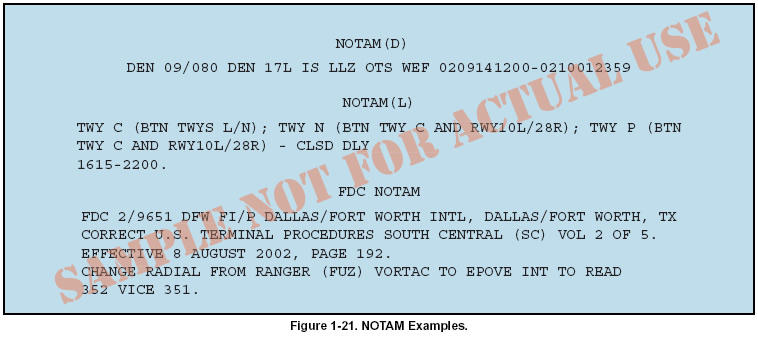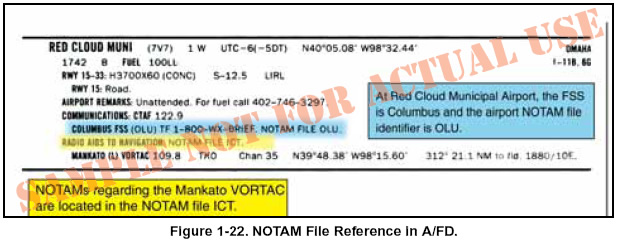 |
|
| INSTRUMENT PROCEDURES HANDBOOK |
|
NOTICE TO AIRMEN Since the NAS is continually evolving, Notices to Airmen (NOTAM) provide the most current essential flight operation information available, not known sufficiently in advance to publicize in the most recent aeronautical charts or A/FD. NOTAMs provide information on airports and changes that affect the NAS that are time critical and in particular are of concern to IFR operations. Published FAA domestic/international NOTAMs are available by subscription and on the Internet. Each NOTAM is classified as a NOTAM (D), a NOTAM (L), or an FDC NOTAM. [Figure 1-21]
A NOTAM (D) or distant NOTAM is given dissemination beyond the area of responsibility of a Flight Service Station (AFSS/FSS). Information is attached to hourly weather reports and is available at AFSSs/FSSs. AFSSs/FSSs accept NOTAMs from the following personnel in their area of responsibility: Airport Manager, Airways Facility SMO, Flight Inspection, and Air Traffic. They are disseminated for all navigational facilities that are part of the U.S. NAS, all public use airports, seaplane bases, and heliports listed in the A/FD. The complete NOTAM (D) file is maintained in a computer database at the National Weather Message Switching Center (WMSC) in Atlanta, Georgia. Most air traffic facilities, primarily AFSSs/FSSs, have access to the entire database of NOTAM (D)s, which remain available for the duration of their validity, or until published. A NOTAM (L) or local NOTAM requires dissemination locally, but does not qualify as NOTAM (D) information. These NOTAMs usually originate with the Airport Manager and are issued by the FSS/AFSS. A NOTAM (L) contains information such as taxiway closures, personnel and equipment near or crossing runways, and airport rotating beacon and lighting aid outages. A separate file of local NOTAMs is maintained at each FSS/AFSS for facilities in the area. NOTAM (L) information for other FSS/AFSS areas must be specifically requested directly from the FSS/AFSS that has responsibility for the airport concerned. Airport/Facility Directory listings include the associated FSS/AFSS and NOTAM file identifiers. [Figure 1-22]
FDC NOTAMs are issued by the National Flight Data Center (NFDC) and contain regulatory information such as temporary flight restrictions or amendments to instrument approach procedures and other current aeronautical charts. FDC NOTAMs are available through all air traffic facilities with telecommunications access. Information for instrument charts is supplied by Aviation System Standards (AVN) and much of the other FDC information is extracted from the NOTAM (D) System. The Notices to Airmen Publication (NTAP) is published by Air Traffic Publications every 28 days and contains all current NOTAM (D)s and FDC NOTAMs (except FDC NOTAMs for temporary flight restrictions) available for publication. Federal airway changes, which are identified as Center Area NOTAMs, are included with the NOTAM (D) listing. Published NOTAM (D) information is not provided during pilot briefings unless requested. Data of a permanent nature are sometimes printed in the NOTAM publication as an interim step prior to publication on the appropriate aeronautical chart or in the A/FD. The NTAP is divided into four parts:
a. Airway NOTAMs reflecting airway changes that fall within an ARTCC’s airspace;
If you plan to fly internationally, you can benefit by accessing Class I international ICAO System NOTAMs, that include additional information. These help you differentiate IFR versus VFR NOTAMs, assist pilots who are not multilingual with a standardized format, and may include a “Q” line, or qualifier line that allows computers to read, recognize, and process NOTAM content information. |

